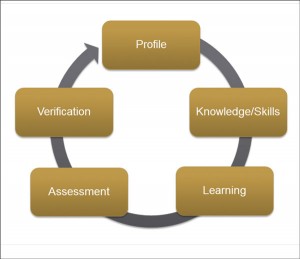HSET Corner: Shifting gears from a culture of training to a culture of competence assurance
By Joanne Liou, editorial coordinator

The introduction of new technologies, crews and regulations are affecting the way companies are approaching training and development. Competency assurance programs (CAPs) are gaining popularity and guiding a shift from a culture of training to a culture of competence. “It’s really about demonstration,” Martin Payne, technical director – Americas for Petrofac Training Services, said at the 2012 IADC Health, Safety, Environment and Training Conference & Exhibition on 7 February in Houston. “It’s not just about going and doing training. It’s really about ‘Don’t tell me, show me.’ ”
Competence encompasses three elements: knowledge, skills and experience. “Experience is often interchanged with ability and attitude, but it’s really about behavior,” Mr Payne said. Building a competence program begins with establishing a profile: what a person needs to do when conducting his or her job. Then knowledge and skills are defined, followed by learning, assessment and, lastly, verification. “When you talk about competency, they’re actually the building blocks of job requirements,” Mr Payne explained. “One of the biggest problems we have with competency is that people overcomplicate it. It needs to be pragmatic, and it needs to be fit for purpose.”
In preparation for the big crew change, knowledge management and transfer of information is critical to help the transition. On-the-job training is a critical component in a CAP. “A good, structured on the job training program is key to most successful and effective work forces,” Mr Payne said.
In a traditional training program, a scored exam might pass for an assessment. In a CAP, however, an assessment is a judgment by an assessor about an employee’s behavior. In the assessment process, an assessor becomes familiar with the program and requirements of the assessment. Based on observation, questioning, personal statements and simulation, the assessor makes a judgment of the person’s competence.
“An assessor makes a judgment – yes or no, competent or not yet competent – provides feedback and records the evidence,” Mr Payne explained. To provide an everyday example of an assessment, Mr Payne described the process to get a driver’s license. “You study the rules of the road. You do the drives under supervision. You do, in theory, a component on the computer,” he said. “Then you do the driving test with the examiner. He or she makes a judgment. You’re competent to drive; you’re not competent to drive.”
The CAP does not end after assessment but is a continuous process. New equipment in the work environment, a change in procedures or complacency can make people unconsciously not competent. “They don’t know they’re doing it wrong,” Mr Payne stated, “and that’s when they become a safety-critical risk.” Including a validity period in a competence unit will ensure periodic assessments, and the length of that period “depends on the organization and how safety-critical the opportunity is,” he added.
The last step in developing a competency program is to verify it. Verification, which can be done internally or by a third party, ensures the framework in the competency program is being applied uniformly, consistently and is valid.
Although CAPs are not required or regulated by governments, more and more operators are demanding their drilling contractors to have such a program in place. “SEMS seems to be the biggest global driver for competency programs,” Jenni Lewis, business solutions manager – Americas for Petrofac, said at the IADC conference. “Competency is never listed by the term or exact definition, but it is stated that you will have the knowledge and skills identified for each position and the means to evaluate them.”
However, companies should consider not only the need to meet operators’ requirements but the overall benefits of having a safer and more effective work force.
A CAP offers a roadmap for employee development and training. “If you have a CAP in place, you’re more targeted with your training. It shows you where the gaps will be in a person’s skills and knowledge,” Mr Payne explained. “That is one of the major things about making a supervisor or manager an assessor because they assess the crew they work with. They actually know their capability.”




